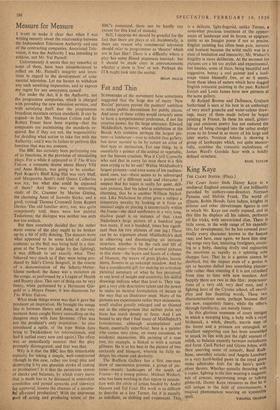Fat and Thin
SUPPORTERS of the movement have sometimes suggested that the large size of many 'New Realist' pictures proves the painters' ambition to make public decorations for public places. And some of these artists would certainly seem to have a temperamental preference, if not the creative power, for the large utterance. Edward Middleditch, however, whose exhibition at the Beaux Arts contains perhaps the largest pic- ture—a landscape—ever to inhabit that gallery, has never seemed to he by nature an artist of that type or inclination. For one thing, he is essentially a painter of the animal or vegetable, not the human creation. Was it Cyril Connolly who said that in every tat man there is a thin man crying to be let out? Within Middleditch's largest pictures—and even some of his medium- sized ones, too—there seems to be submerged a painter of a different scale and character, I suspect that his talent is really for quiet, deli- cate pictures, that his talent is conservative and charming, that he is another William Nichol- son. Like Nicholson he often gives a subject a temporary novelty by looking at it from an unusual angle or placing it eccentrically within the frame—the dead sunflowers in a very long, shallow panel is an instance of that. (And Nicholson's large picture of a hundred jugs was many, if not a hundred, times less signifi- cant than his tiny pictures of one jug.) There can be no argument about Middleditch's skill in observing and disentangling an intricate structure, whether it be the rush and lift of turbulent water—the theme of several pictures in this show—the layers and facets of a cluster of blossom, the weave of grass blades, leaves, stems, flowers in an unkempt meadow. And he has a considerable gift for making an articulate pictorial summary of what he has perceived, at one level of insight and creativity; his skilful drawings indicate what that level is. They sug- gest a very able descriptive talent and the power to make an incisive formulation of nature in the way that an illustrator must. Many of his pictures are experiments rather than statements, small studies greatly enlarged and so thinned out in the enlargement that neither paint nor form has much density or force. And I am bound to say that I find many of Middleditch's formulations, although accomplished and fluent, essentially superficial; here is a painter who comes very close, on many occasions, to academic mannerism. His painting of a rose tree, for example, is flicked in with a certain glibness. He is at his best in the picture of two cockerels and blossom, wherein he fully in- dulges his charm and dexterity.
The Redfern Gallery has a first one-man show of uncommon promise, a group of pic- tures—mainly landscapes of the south of France—by a young painter, Michael Wishart, who has been working in that region in associa- tion with the circle of artists headed by Andre Masson and Tal Coat. His work is as difficult to describe as a late Turner, for it is equally as indefinite, as shifting and evanescent. This
is a delicate, light-fingered, unlike Turner, a somewhat precious treatment of the appear- ances of landscape and its forms, as epigram- matic as an Imagist poem if not so precise. English painting has often been pale, nervous and hesitant because the artist really was in a state of hesitation and insecurity; Mr. Wishart's fragility is more deliberate. At the moment his pictures are a bit too stylish and experimental. but besides, some of them, being beautiful and suggestive, betray a real painter and a land- scape vision blessedly, free, or so it seems, from those ideas of nature which have dogged English romantic painting in the past. Richard Eurich and Louis James have new pictures at the same gallery.
At Roland Browse and Delbanco, Graham Sutherland is seen at his best in an anthology of very small gouache and water-colour draw- ings, many of them made before he began painting in France. In these his small, glitter- ing and ominous poetry has not endured the labour of being changed into the rather stodgy prose to be found in so many of his large and later works. Norman Adams is showing a group of landscapes which, not quite success- fully, combine the romantic melodrama of James Ward's Gordale Scar with a boldly defined structure.
BASIL TAYLOR


































 Previous page
Previous page